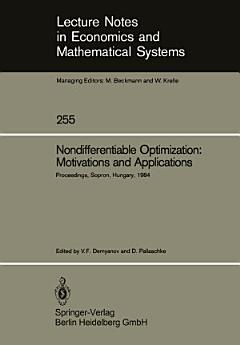Nondifferentiable Optimization: Motivations and Applications: Proceedings of an IIASA (International Institute for Applied Systems Analysis) Workshop on Nondifferentiable Optimization Held at Sopron, Hungary, September 17–22, 1984
Vladimir F. Demyanov · Diethard Pallaschke
জুন ২০১৩ · Springer Science & Business Media
ইবুক
355
পৃষ্ঠা
reportমূল্যাংকন আৰু পৰ্যালোচনা সত্যাপন কৰা হোৱা নাই অধিক জানক
এই ইবুকখনৰ বিষয়ে
The International Institute for Applied Systems Analysis (IIASA) in Laxenburg, Austria, has been involved in research on nondifferentiable optimization since 1976. IIASA-based East-West cooperation in this field has been very productive, leading to many important theoretical, algorithmic and applied results. Nondifferentiable optimi zation has now become a recognized and rapidly developing branch of mathematical programming. To continue this tradition, and to review recent developments in this field, IIASA held a Workshop on Nondifferentiable Optimization in Sopron (Hungary) in September 1964. The aims of the Workshop were: 1. To discuss the state-of-the-art of nondifferentiable optimization (NDO), its origins and motivation; 2. To compare-various algorithms; 3. To evaluate existing mathematical approaches, their applications and potential; 4. To extend and deepen industrial and other applications of NDO. The following topics were considered in separate sessions: General motivation for research in NDO: nondifferentiability in applied problems, nondifferentiable mathematical models. Numerical methods for solving nondifferentiable optimization problems, numerical experiments, comparisons and software. Nondifferentiable analysis: various generalizations of the concept of subdifferen tials. Industrial and other applications. This volume contains selected papers presented at the Workshop. It is divided into four sections, based on the above topics: I. Concepts in Nonsmooth Analysis II. Multicriteria Optimization and Control Theory III. Algorithms and Optimization Methods IV. Stochastic Programming and Applications We would like to thank the International Institute for Applied Systems Analysis, particularly Prof. V. Kaftanov and Prof. A.B. Kurzhanski, for their support inorganiz ing this meeting.
এই ইবুকখনক মূল্যাংকন কৰক
আমাক আপোনাৰ মতামত জনাওক।
পঢ়াৰ নির্দেশাৱলী
স্মাৰ্টফ’ন আৰু টেবলেট
Android আৰু iPad/iPhoneৰ বাবে Google Play Books এপটো ইনষ্টল কৰক। ই স্বয়ংক্রিয়ভাৱে আপোনাৰ একাউণ্টৰ সৈতে ছিংক হয় আৰু আপুনি য'তে নাথাকক ত'তেই কোনো অডিঅ'বুক অনলাইন বা অফলাইনত শুনিবলৈ সুবিধা দিয়ে।
লেপটপ আৰু কম্পিউটাৰ
আপুনি কম্পিউটাৰৰ ৱেব ব্রাউজাৰ ব্যৱহাৰ কৰি Google Playত কিনা অডিঅ'বুকসমূহ শুনিব পাৰে।
ই-ৰীডাৰ আৰু অন্য ডিভাইচ
Kobo eReadersৰ দৰে ই-চিয়াঁহীৰ ডিভাইচসমূহত পঢ়িবলৈ, আপুনি এটা ফাইল ডাউনল’ড কৰি সেইটো আপোনাৰ ডিভাইচলৈ স্থানান্তৰণ কৰিব লাগিব। সমৰ্থিত ই-ৰিডাৰলৈ ফাইলটো কেনেকৈ স্থানান্তৰ কৰিব জানিবলৈ সহায় কেন্দ্ৰত থকা সবিশেষ নিৰ্দেশাৱলী চাওক।






